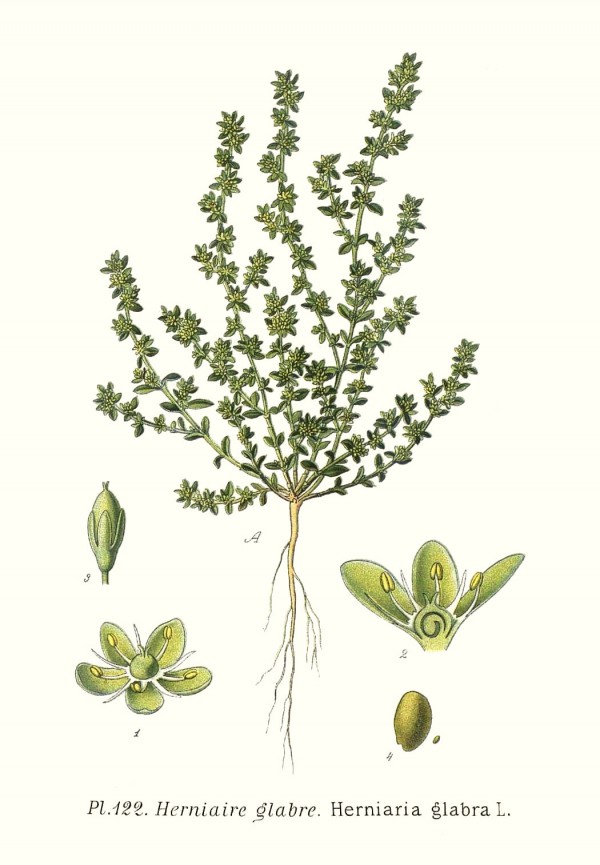Herniaria glabra L. - Caryophyllaceae - smooth repturewort, Kahles Bruchkraut
„Annual, biennial, or perennial herb, light to yellowish green, glabrous or puberulent, some-times with woody caudex. Stems spreading to prostrate, 5-35 cm. Leaves opposite, or distalmost alternate; stipules 0.5-1.5 mm; blade obovate-elliptic to sub-orbiculate, 3-7(-10) mm, glabrous or sometimes short-ciliate. Inflorescences mostly leaf-opposed, 6-10-flowered. Flowers 1-1.5 (-1.8) mm, usually glabrous or sometimes short-ciliate; native to Europe, West Sibiria, West Asia, North Africa; introduced to North America.
http://www.efloras.org/florataxon.aspx?flora_id=1&taxon_id=220006279
Used in folk medicine as a diuretic, against urinary calculi, renal gravel and bladder spasms.
„The extract does not appear to have significant toxicity (except at high doses). In view of the doses consumed empirically in traditional medicine in Morocco, there is a wide margin of safety for the therapeutic use of Herniaria glabra.“
[Acute and sub-chronic toxicity of an aqueous extract of the leaves of Herniaria glabra in rodents. Rhiouani, H., El-Hilaly, J., Israili, Z. H., Lyoussi, B., Journal of ethnopharmacology, Vol.118(3), 2008, 378-386]
The herb contains saponins with triterpenes as aglycon.
[New triterpene saponins from Herniaria glabra. Freiler, M., et al., Helvetica chimica acta, Vol.79(2), 1996, 385-390]
Dried herb smells pleasantly coumarin-like as it delivers herniarin (7-methoxycoumarin) and umbelliferon (7-hydroxycoumarin). (Herniarin was already isolated from Herniaria hirsuta in 1889 by Barth and Herzig)
[Über das diuretische Prinzip von Herniaria glabra L. Hörhammer, L., Wagner, H., & Probst, W. , Naturwissenschaften, Vol.47(3), 1960, 63-64]
In a study concerning the influence of plant extracts extracts on bacterial survival and virulence factors involved in tissue colonization and biofilm formation of the uropathogenic Escherichia coli rods, Herniaria glabra extract showed the highest growth-inhibitory effect.
[Medicinal plants extracts affect virulence factors expression and biofilm formation by the uropathogenic Escherichia coli. Wojnicz, D., Kucharska, A. Z., Sokół-Łętowska, A., Kicia, M., Tichaczek-Goska, D., Urological research, Vol.40(6), 2012, 683-697]
http://link.springer.com/article/10.1007/s00240-012-0499-6/fulltext.html

Herniaria glabra L.; Masclef, A., Atlas des plantes de France, vol.2 t.122
http://botanicalillustrations.org/species.php?id_species=509037
Herniaria glabra
© Rolf Marschner (2006),
www.botanische-spaziergaenge.at
